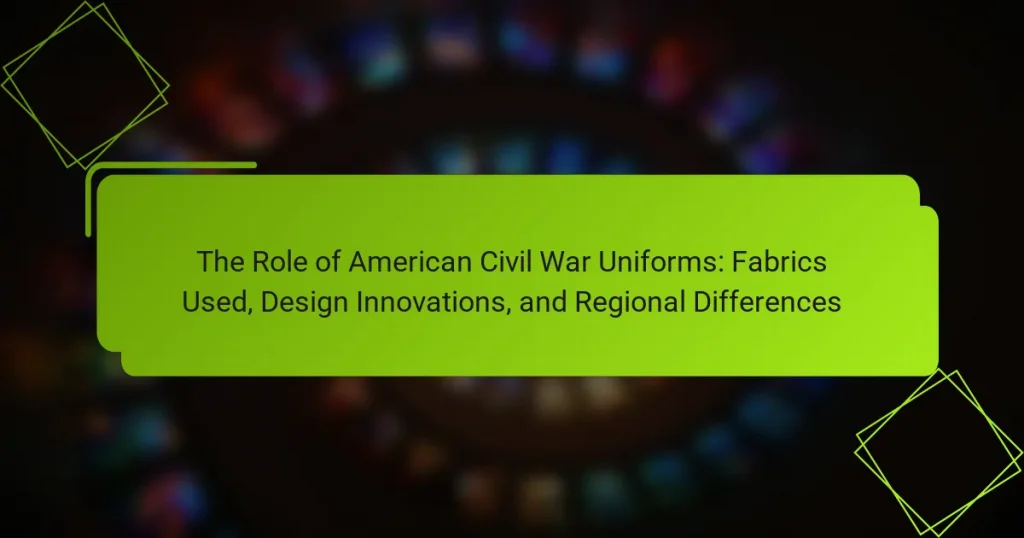American Civil War uniforms were the standardized clothing worn by soldiers from 1861 to 1865, distinguishing Union and Confederate forces. These uniforms typically consisted of wool coats, trousers, and hats, with blue representing Union troops and gray for Confederates. The article explores the design innovations and fabric choices that emerged during the war, highlighting the practical features that enhanced functionality in combat. It also discusses the impact of these uniforms on military organization, morale, and their lasting influence on modern military attire, including the establishment of standardized colors, designs, and rank insignia. Additionally, the article addresses regional differences in manufacturing capabilities that affected uniform production.

What are American Civil War Uniforms and their significance?
American Civil War uniforms were the standardized clothing worn by soldiers during the American Civil War (1861-1865). They served to distinguish between Union and Confederate forces, fostering a sense of identity and unity among troops. Uniforms typically included a wool coat, trousers, and a hat, often in distinct colors like blue for Union soldiers and gray for Confederate soldiers. The design and fabric used reflected the available resources and regional differences in the manufacturing capabilities of the North and South. Uniforms also evolved throughout the war, incorporating practical features for better functionality in combat. The significance of these uniforms extends beyond aesthetics; they symbolized loyalty, heritage, and the ideological divides of the time. The uniforms played a crucial role in military organization and morale, influencing how soldiers and civilians perceived the war.
How did American Civil War Uniforms evolve over time?
American Civil War uniforms evolved significantly from 1861 to 1865. Initially, both Union and Confederate uniforms were based on pre-war military styles. The Union adopted a dark blue wool fabric for its uniforms, while the Confederacy used gray, often made from various materials due to supply shortages.
As the war progressed, uniform designs began to change. The Union introduced more standardized patterns and improved manufacturing techniques. This included the use of brass buttons and insignia to signify rank and unit.
Confederate uniforms, however, became more varied and less standardized. Due to resource scarcity, many soldiers wore civilian clothing or mixed fabrics, leading to a lack of uniformity.
By the end of the war, both sides had recognized the importance of distinct uniforms for identification and morale. The evolution reflected broader trends in military fashion and logistics during wartime.
What historical events influenced the design of these uniforms?
The design of American Civil War uniforms was influenced by several historical events. The outbreak of the Civil War in 1861 necessitated rapid uniform production for both Union and Confederate forces. The need for standardization arose from the chaos of initial battles. Early conflicts revealed the importance of visibility and identification on the battlefield. Additionally, advancements in textile manufacturing allowed for the use of wool and cotton blends. The influence of European military styles also shaped uniform designs. Furthermore, regional differences impacted color choices, with blue for the Union and gray for the Confederacy. The evolution of military tactics during the war further prompted changes in uniform functionality.
How did the needs of soldiers shape uniform development?
The needs of soldiers significantly influenced uniform development during the American Civil War. Soldiers required durable materials for protection against harsh weather and combat conditions. This need led to the adoption of wool and cotton fabrics, which provided warmth and breathability. Additionally, uniforms needed to be functional, allowing for ease of movement. This resulted in design innovations like the introduction of the sack coat, which offered better mobility.
The need for identification also shaped uniform colors and insignia. Distinctive colors helped troops recognize allies and enemies on the battlefield. The use of blue for Union soldiers and gray for Confederate troops became standardized. Furthermore, soldiers needed uniforms that could be mass-produced. This demand led to the establishment of uniform factories, streamlining production processes.
The evolving needs of soldiers directly impacted the design, materials, and production methods of military uniforms during this period.
What materials were commonly used in American Civil War Uniforms?
American Civil War uniforms were commonly made from wool, cotton, and linen. Wool was favored for its durability and warmth, making it suitable for various weather conditions. Cotton was often used for summer uniforms due to its breathability. Linen was less common but provided a lightweight option for soldiers in warmer climates. The use of these materials varied by region and availability. Many uniforms were produced quickly, leading to differences in fabric quality and color. Historical records indicate that both the Union and Confederate armies relied heavily on these materials for their uniforms.
What types of fabrics were preferred for making these uniforms?
Wool and cotton were the preferred fabrics for making American Civil War uniforms. Wool provided warmth and durability, making it suitable for various weather conditions. Cotton was often used for lighter uniforms, especially in warmer climates. The use of these fabrics was influenced by availability and cost. Wool was more common in northern states, while cotton was frequently used in the southern regions. Historical records indicate that the Union Army primarily used wool for its uniforms, while Confederate uniforms often featured cotton blends. This choice of fabric contributed to the overall functionality and comfort of the soldiers during the war.
How did climate and geography affect fabric choices?
Climate and geography significantly influenced fabric choices during the American Civil War. Regions with warmer climates preferred lighter fabrics such as cotton and linen. These materials provided breathability and comfort in hot conditions. In contrast, colder regions favored heavier fabrics like wool for warmth and durability. Geographic availability also played a role. Areas with abundant cotton production naturally utilized it for uniforms. Conversely, regions with limited cotton access relied more on wool or other locally available materials. This resulted in distinct uniform styles that reflected both the environmental conditions and available resources of each region.

What design innovations emerged in American Civil War Uniforms?
Design innovations in American Civil War uniforms included the introduction of standardized military patterns. These patterns allowed for easier production and distribution. The use of wool as a primary fabric improved durability and warmth. Additionally, the incorporation of bold colors, such as blue for Union troops and gray for Confederates, facilitated quick identification on the battlefield. The adoption of the forage cap, or “kepi,” represented a shift from traditional hats. This design was lighter and more practical for soldiers. Furthermore, the use of epaulets and insignia helped denote rank and unit affiliation. These innovations reflected both practical needs and military organization during the conflict.
How did functionality influence uniform design during the war?
Functionality significantly influenced uniform design during the war. Military uniforms were designed for practicality and effectiveness on the battlefield. Fabrics were chosen for durability and weather resistance. The cut and fit of uniforms allowed for ease of movement. Features like pockets were added for carrying essential items. Colors were selected for camouflage and identification. Historical records show that these designs aimed to enhance soldier performance. The emphasis on functionality helped reduce casualties and improve operational efficiency.
What specific design features were introduced for practicality?
The specific design features introduced for practicality in American Civil War uniforms included the use of durable fabrics and functional silhouettes. Uniforms were made from wool and cotton blends to withstand various weather conditions. The design incorporated simpler cuts to allow for ease of movement during combat. Pockets were added for carrying essential items like ammunition and tools. The use of brass buttons provided both functionality and durability. Reinforced seams were implemented to enhance the lifespan of the garments. Additionally, the introduction of standardized colors helped in quick identification of units. These design features collectively improved the overall functionality and usability of the uniforms in military operations.
How did rank and unit affiliation affect uniform design?
Rank and unit affiliation significantly influenced uniform design during the American Civil War. Different ranks were visually distinguished by specific insignia and colors. For example, officers wore more elaborate uniforms with unique insignia to signify their higher status. Unit affiliation also played a crucial role in color choices and patterns. Regiments often adopted specific colors to create a sense of identity and unity among soldiers. The Union army primarily used blue, while the Confederate army favored gray. These choices were not only practical but also symbolic, representing loyalty and allegiance. Historical records show that these design elements helped in identifying troops on the battlefield.
What role did regional differences play in uniform styles?
Regional differences significantly influenced uniform styles during the American Civil War. Variations in climate and available materials affected design choices. For example, Southern uniforms often used lighter fabrics due to warmer temperatures. In contrast, Northern uniforms utilized wool for durability and warmth in colder climates. Additionally, regional pride manifested in color choices and insignia. The Confederate gray and Union blue became symbols of identity. Local production capabilities also dictated uniform styles. Regions with textile mills produced more standardized uniforms, while others relied on less uniform, locally made garments. These factors combined to create a diverse array of styles across both armies.
How did Northern and Southern uniforms differ in design and fabric?
Northern and Southern uniforms differed significantly in design and fabric. Northern uniforms, primarily worn by Union soldiers, were typically made of wool and featured a more standardized design. They often had a dark blue color, which was both practical and symbolic. Southern uniforms, worn by Confederate soldiers, varied widely in color and fabric. Many were made from lighter materials like cotton due to resource scarcity. The common color for Confederate uniforms was gray, though shades varied greatly. The differences in fabric and design reflected the logistical capabilities and industrial resources available to each side during the Civil War.
What were the cultural influences on regional uniform variations?
Cultural influences on regional uniform variations during the American Civil War included geography, local customs, and available resources. Different regions had distinct climates that affected fabric choices. For instance, Southern uniforms often used lighter materials due to warmer weather. Local customs influenced colors and styles, reflecting regional identities. The availability of materials also varied; Northern states had better access to wool, while Southern states relied on cotton. Additionally, the influence of military traditions shaped design elements unique to each region. Historical records indicate that these factors collectively contributed to the diversity seen in Civil War uniforms.

What lasting impacts did American Civil War Uniforms have on military attire?
American Civil War uniforms significantly influenced military attire in subsequent conflicts. The introduction of standardized colors and designs established a framework for modern military uniforms. Blue and gray became iconic, influencing the color schemes of future armies. The use of wool and cotton fabrics set a precedent for material choices in military clothing. Innovations in tailoring improved fit and functionality, leading to more practical designs. The concept of rank insignia emerged during this period, which is still used today. Additionally, the war highlighted the importance of uniformity for identification and morale. Overall, these uniforms laid the groundwork for contemporary military apparel.
How have American Civil War Uniforms influenced modern military uniforms?
American Civil War uniforms have significantly influenced modern military uniforms. The introduction of standardized designs during the Civil War set a precedent for uniformity in military attire. These uniforms featured distinctive colors and insignia, which are now common in modern military dress. The use of wool and cotton fabrics in Civil War uniforms laid the groundwork for fabric choices in contemporary military clothing. Innovations such as the incorporation of functional pockets and buttons improved practicality, a trend that continues today. Additionally, the emphasis on rank insignia and unit identification in Civil War uniforms has shaped how modern militaries denote hierarchy and affiliation. Overall, the Civil War era established foundational elements that remain integral to military uniform design today.
What aspects of Civil War uniform design are still relevant today?
Civil War uniform design influences modern military attire. Key aspects include the use of wool fabrics for durability and warmth. This material remains popular in contemporary uniforms. The incorporation of distinctive colors for identification is also relevant today. Modern military uniforms often feature unique patterns for unit recognition. Functional design elements, such as pockets and epaulets, are still utilized. The structured fit of Civil War uniforms informs current tailoring standards. Additionally, the emphasis on practicality in design continues to influence military fashion.
What practical tips can be drawn from the study of American Civil War Uniforms?
Studying American Civil War uniforms provides practical tips for modern clothing design and historical reenactments. First, attention to fabric choice is crucial. Wool was commonly used for its durability and warmth. Understanding the significance of color can enhance authenticity; blue represented Union soldiers, while gray was associated with the Confederacy. Tailoring techniques from that era can inform modern fit and style. Knowledge of insignia and rank markings enhances historical accuracy in reenactments. Additionally, recognizing regional variations in uniform design can inspire unique interpretations. Researching historical sources, such as photographs and military records, can provide valuable insights.
How can understanding historical uniforms enhance modern military training?
Understanding historical uniforms can enhance modern military training by providing insights into tactical design and soldier morale. Historical uniforms reflect the technological advancements of their time. For instance, during the American Civil War, the introduction of wool and cotton blends improved durability and comfort. Analyzing these materials helps modern militaries select appropriate fabrics for various climates.
Additionally, the colors and patterns used in historical uniforms inform camouflage techniques. Understanding how visibility affected battlefield outcomes can guide current training in concealment strategies. Historical uniforms also reveal the psychological impact of appearance on troop cohesion and identity. Studies show that soldiers’ morale can be influenced by their uniforms, fostering a sense of pride and unity.
Furthermore, examining the evolution of uniforms highlights the importance of adaptability in military strategy. The transition from bright colors to more subdued tones illustrates the need for change in response to enemy tactics. Overall, integrating lessons from historical uniforms into modern training enhances both the practical and psychological aspects of military preparedness.
What lessons can be learned from the fabric and design choices of the era?
The fabric and design choices of the American Civil War era highlight the importance of functionality and adaptability. Uniforms were primarily made from wool due to its durability and insulation properties. The use of different colors and patterns reflected regional affiliations and military branches. Innovations included the incorporation of brass buttons and epaulettes for rank distinction. These design elements facilitated quick identification of soldiers in the field. Additionally, the need for mass production led to standardized patterns, which streamlined manufacturing processes. Historical records indicate that these choices significantly impacted troop morale and cohesion. Understanding these lessons can inform modern military uniform design by emphasizing practicality and identity.
The primary entity of the article is American Civil War uniforms, which were standardized clothing worn by soldiers during the Civil War from 1861 to 1865. This article examines the significance of these uniforms in distinguishing Union and Confederate forces, the evolution of their design and fabric choices, and the regional differences that influenced their styles. Key topics include the materials used, design innovations for functionality, and the cultural impacts that shaped uniform variations. Additionally, the article explores how these historical uniforms have influenced modern military attire and training practices.




